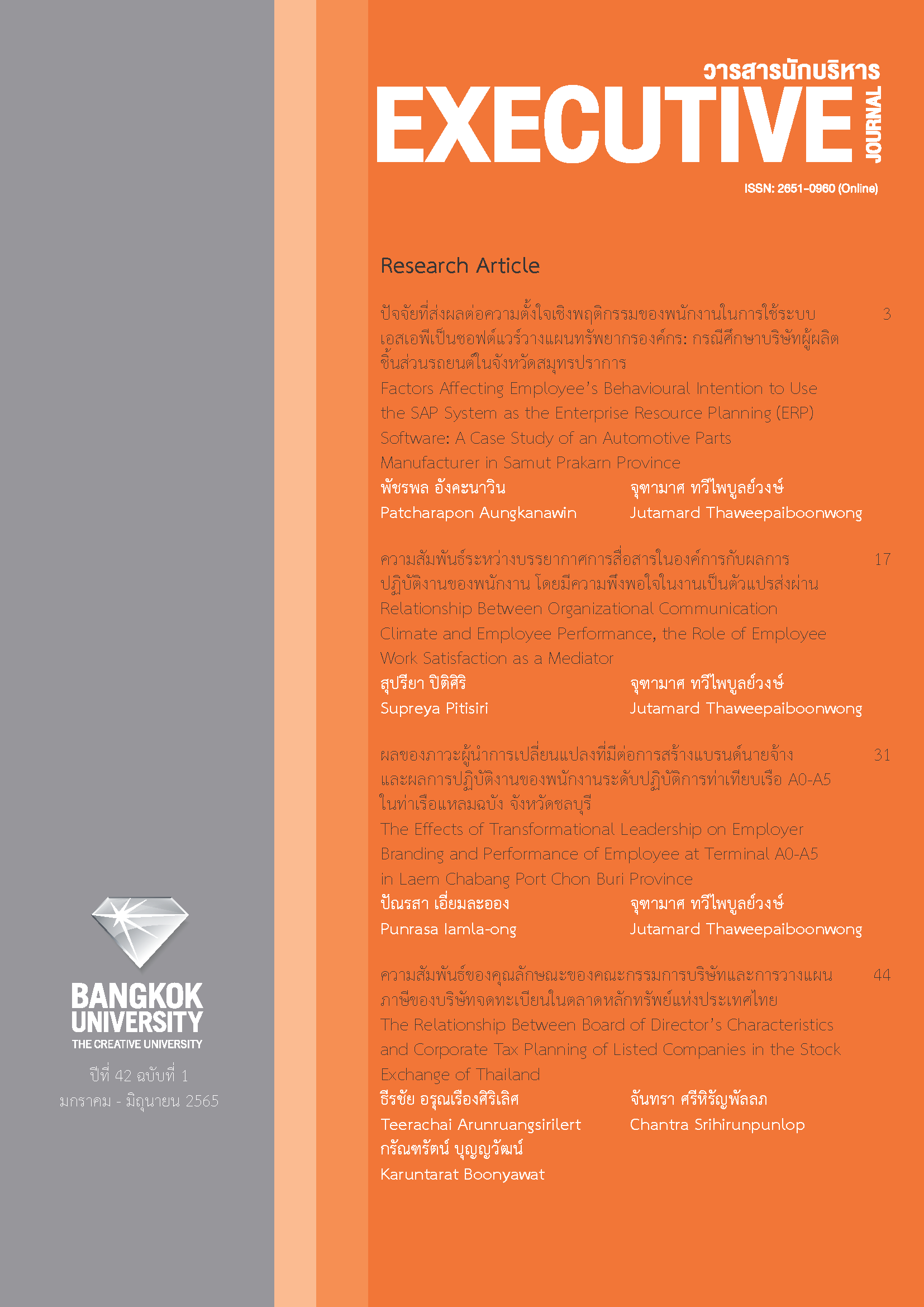Factors Affecting Employee’s Behavioural Intention to Use the SAP System as the Enterprise Resource Planning (ERP) Software: A Case study of an Automotive Parts Manufacturer in Samut Prakarn Province
Main Article Content
Abstract
This quantitative research aimed to analyze the effects of the multiple factors, namely task-technology fit, facilitating conditions, social influence, perceived usefulness, perceived ease of use, and attitude, on adopting the SAP system as the Enterprise Resource Planning (ERP) system, toward employees’ behavioural intention to use it. Data collection was conducted through questionnaire with 225 employees involved in the system in an automotive parts manufacturer in Samut Prakarn Province. A stratified random sampling was used to ensure a proportionately distributing sample size across departments. Both descriptive and inferential statistics, namely structural equation modeling, were employed for data analysis. The results revealed that the behavioural intention to use the system was directly influenced by perceived usefulness and the attitude towards adopting the technology. In addition, it was also indirectly influenced by the task-technology fit, facilitating conditions, and social influence, with perceived usefulness, perceived ease of use, and attitude towards adopting the technology serving as mediator variables at a significant level of 0.05.
Article Details

This work is licensed under a Creative Commons Attribution-NonCommercial-NoDerivatives 4.0 International License.
The manuscript submitted for publication must be the original version, submitted only to this particular journal with no prior acceptance for publication elsewhere in other academic journals. The manuscript must also not violate the copyright issue by means of plagiarism.
References
Boonyong, J. (2017). Kānphatthanā mō dē lakān yō̜m rap theknōlōyī thāng kānngœ̄n bō̜ribot kān sư̄ khāi hun phān ʻǣp phlikhēchan Streaming bon mư̄ thư̄ [The financial technology adoption model of streaming application] (Master’s thesis, Thammasat University).
Byrne, M. B. (2010). Structural equation modeling with AMOS: Basic concepts, application, and programming (2nd ed.). New York: Routledge.
Cronbach, L. J. (1951). Coefficient alpha and the internal structure of tests. Psychometrika, 16(3), 297-334.
Davis, F. D. (1986). A technology acceptance model for empirically testing new end-user information systems: Theory and results (Doctoral dissertation, Massachusetts Institute of Technology).
Goodhue, D. L., & Thompson, R. L. (1995). Task-technology fit and individual performance. MIS Quarterly. 19(2), 213-236.
Hair, J. F., Ringle, C. M., & Sarstedt, M. (2011). PLS-SEM: Indeed a silver bullet. Journal of Marketing Theory and Practice, 19(2), 139-152.
Hair Jr., J. F., Black, W. C., Babin, B. J., & Anderson, R. E. (2010). Multivariate data analysis: A global perspective. Upper Saddle River, NJ: Pearson.
Herrero, A., Martín, S. H., & Garcia-De los Salmones, M. M. (2017). Explaining the adoption of social networks sites for sharing user-generated content: A revision of the UTAUT2. Computers in Human Behavior, 71, 209-217. https:/doi.org/10.1016/j.chb.2017.02.007
Khanthaniyom, P. (2015). Khō̜ nænam læ phon khō̜ng kānchai theknōlōyī kānthamngān rūam kan phān sư̄ ʻilekthrō̜nik nai sathāban kānsưksā [Antecedents and consequences of e-collaboration use in academic institutions] (Master’s thesis, Thammasat University).
Khantichoti, P., & Suriyarpa, C. (2018). Kānnam rabop SAP khao mā chai ngān phư̄a phœ̄m prasitthiphāp nai kān patibat ngān [The Implementation of SAP to enhance operational efficiency]. Kasem Budit Journal, 19(Special issue), 47-62.
Kim, Y. G., & Woo, E. (2016). Consumer acceptance of a quick response (QR) code for the food traceability system: Application of an extended technology acceptance model (TAM). Food Research International, 85, 266-272. https://doi.org/10.1016/j.foodres.2016.05.002
Kline, R. B. (2005). Principles and practice of structural equation modeling (2nd ed.). New York: Guilford.
Nikou, A. S., & Economides, A. A. (2017). Mobile-based assessment: Investigating the factors that influence behavioral intention to use. Computers & Education, 109, 56-73. http://dx.doi.org/10.1016/j.compedu.2017.02.005
Rovinelli, R. J., & Hambleton, R. K. (1977). On the use of content specialists in the assessment of criterion-referenced test item validity. Dutch Journal of Education Research, 2, 49-60.
Sarstedt, M., Ringle, C. M., Smith, D., Reams, R., & Hair, J. F. (2014). Partial least squares structural equation modeling (PLS-SEM): A useful tool for family business researchers. Journal of Family Strategy, 5(1), 105-115.
Taengjui, R., & Rakbumrung, W. (2020). Patčhai thī song phon tō̜ kānyō̜mrap tonbǣp nawattakam kānbō̜rihān čhatkān rottū dōisān sāthārana bō̜risat Kānčhanaburī ʻekphrēt kat [Innovative prototype for public van transportation management of Kanchanaburi Express Co., Ltd.]. Journal of Innovation and Management, 5, 72-86.
Thanabordeelertmeta, K., & Khongmalai, O. (2019). Kānchai mōdēn samakān chœ̄ng khrōngsāng phư̄a sưksā kān thāi ʻōn theknōlōyī: Kō̜ranī sưksā bō̜risat lūk nai ʻutsāhakam yān yon nai prathēt Thai [Structural equation model used for technology transfer studying: A case study of an automotive subsidiary in Thailand]. WMS Journal of Management, 9(1), 1-13.
Theerasopee, N., & Ottamakorn, C. (2019). Patčhai thī mī ʻitthiphon tō̜ khwāmtangčhai chœ̄ng phrưttikam nai kānchai theknōlōyī wep phō̜than khō̜ng kān rīan kānsō̜n nai rabop pœ̄t Thai MOOC [Influence factors in the behavioral intention of the use of the web portal Thai MOOC educational system], Silpakorn University Journal, 39(5), 96-116.
Tulanon, S. (2019). Kānyō̜mrap theknōlōyī thī mī phon tō̜ kāntatsinčhai sư̄ sinkhā ʻō̜nlai khō̜ng phūsūngʻāyu [Accepting technology affects decision to buy online products of elderly] (Master’s thesis, Naresuan University).
Venkatesh, V., Morris, M. G., Davis, G. B., & Davis, F. D. (2003). User acceptance of information technology: toward a unified view. MIS Quarterly, 27(3), 425-478.
Wu, B., & Chen, X. (2017). Continuance intention to use MOOCs: Integrating the technology acceptance model (TAM) and task technology fit (TTF) model. Computers in Human Behavior, 67, 221-232.
Yongpisanphob, W. (2020, September 10). Nǣonōm ʻutsāhakam chinsūan yān yon [Trend of automotive industrial]. Retrieved July 11, 2021, from https://www.krungsri.com/th/research/industry/industry-outlook/Hi-tech-Industries/Auto-Parts/IO/Industry-Outlook-Auto-Parts


